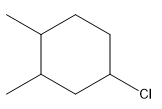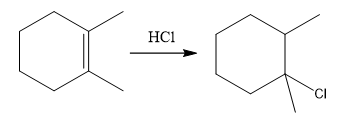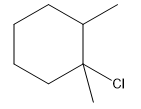
Concept explainers
(a)
Interpretation:
The reaction and complete, detailed mechanism for the reaction is to be drawn.
Concept introduction:
A strong Bronsted acid such as
Answer to Problem 11.27P
The overall reaction for the given compound is

The complete mechanism for the above reaction is

Explanation of Solution
The structure for the given compound

The compound shown above is the alkyl halide compound. This compound is formed by an electrophilic addition reaction of alkene with a strong Bronsted acid
The overall reaction for the given compound is

The above reaction completes in two steps. In the first step, the electrophilic addition step, the proton is added to one carbon with C=C bond, forming the carbocation intermediate. The second step is the coordination step in which the nucleophile attacks the carbocation to yield the product.
The complete mechanism for the above reaction is

The reaction and complete, detailed mechanism for the reaction is drawn on the basis of the mechanism of electrophilic addition reaction of alkenes with strong acid.
(b)
Interpretation:
The reaction and complete, detailed mechanism for the reaction is to be drawn.
Concept introduction:
Alkyl halide is the product of the electrophilic addition reaction of the alkene with a strong Bronsted acid such as
A strong Bronsted acid such as
Answer to Problem 11.27P
The overall reaction for the given compound is

The complete mechanism for the above reaction is

Explanation of Solution
The structure for the given compound

The compound shown above is the alkyl halide compound. This compound is formed by an electrophilic addition reaction of an alkene with a strong Bronsted acid
The overall reaction for the given compound is

The above reaction completes in two steps. In the first step, the electrophilic addition step, the proton is added to one carbon with C=C bond, forming the carbocation intermediate. The second step is the coordination step in which the nucleophile attacks the carbocation to yield the product.
The complete mechanism for the above reaction is

The reaction and complete, detailed mechanism for the reaction is drawn on the basis of the mechanism of electrophilic addition reaction of alkenes with strong acid.
(c)
Interpretation:
The reaction and complete, detailed mechanism for the reaction is to be drawn.
Concept introduction:
Alkyl halide is the product of the electrophilic addition reaction of the alkene with a strong Bronsted acid such as
A strong Bronsted acid such as
Answer to Problem 11.27P
The overall reaction for the given compound is

The complete mechanism for the above reaction is

Explanation of Solution
The structure for the given compound

The compound shown above is the alkyl halide compound. This compound is formed by an electrophilic addition reaction of alkene with a strong Bronsted acid
The overall reaction for the given compound is

The above reaction completes in two steps. In the first step, the electrophilic addition step, the proton added to the internal carbon, forming the the more stable carbocation intermediate, which is tertiary and resonance stabilized. The second step is the coordination step in which the nucleophile attacks the carbocation to yield the product.
The complete mechanism for the above reaction is

The reaction and complete, detailed mechanism for the reaction is drawn on the basis of the mechanism of electrophilic addition reaction of alkenes with strong acid.
(d)
Interpretation:
The reaction and complete, detailed mechanism for the reaction is to be drawn.
Concept introduction:
Alkyl halide is the product of the electrophilic addition reaction of the alkene with a strong Bronsted acid such as
A strong Bronsted acid such as
Answer to Problem 11.27P
The overall reaction for the given compound is

The complete mechanism for the above reaction is

Explanation of Solution
The structure for the given compound

The compound shown above is the alkyl halide compound. This compound is formed by an electrophilic addition reaction of alkene with a strong Bronsted acid
The overall reaction for the given compound is

The above reaction completes in two steps. In the first step, the electrophilic addition step, the proton is added to the internal carbon, forming the the more stable carbocation intermediate, which is tertiary. The second step is the coordination step in which the nucleophile attacks the carbocation to yield the product.
The complete mechanism for the above reaction is

The reaction and complete, detailed mechanism for the reaction is drawn on the basis of the mechanism of electrophilic addition reaction of alkenes with strong acid.
Want to see more full solutions like this?
Chapter 11 Solutions
EBK GET READY FOR ORGANIC CHEMISTRY
- Calculating the pH of a salt solution Calculate the pH at 25 °C of a 0.29M solution of potassium butanoate (KC3H,CO2). Note that butanoic acid (HC3H,CO2) is a weak acid with a pKa of 4.82. Round your answer to 1 decimal place. pH = -0 Х olo 18 Ararrow_forward: At a certain temperature, the equilibrium constant K for the following reaction is 1.58 × 10-12 N2(g) + O2(g) = 2 NO(g) Use this information to complete the following table. Suppose a 38. L reaction vessel is filled with 0.93 mol of N2 and 0.93 mol of O2. What can you say about the composition of the mixture in the vessel at equilibrium? There will be very little N2 and O2. There will be very little NO. What is the equilibrium constant for the following reaction? Be sure your answer has the correct number of significant digits. 2 NO(g) N2(9)+02(9) What is the equilibrium constant for the following reaction? Be sure your answer has the correct number of significant digits. 3 N2(9)+302(g) 6 NO(g) Neither of the above is true. K = ☐ K = ☐ ☐ X10 Х D ? 000 18 Ar Barrow_forwardwhen performing the reaction that involves 2 equivalents of 3-(diethylamino)-phenol and Phthalic anhydride with sulfuric acid and water react to form rhodamine b where the Phthalic anhydride cleaves in acid and how does Excessive Washing (w/ Base) & Subsequent Resonance Structure get affectedarrow_forward
- 3. The strongest acid of the following compounds is ___.A. p-nitrophenol; B. m-nitrophenol; C. o-chlorophenol;D. p-methoxyphenol; E. o-methylphenol Please explain your steps and thought process. Thank you!arrow_forwardUsing the general properties of equilibrium constants At a certain temperature, the equilibrium constant K for the following reaction is 1.3 × 10 4: Cl2(g) + CHCl3(g) HCl(g) + CC₁(g) Use this information to complete the following table. Suppose a 16. L reaction vessel is filled with 1.6 mol of HCI and 1.6 mol of CCl4. What can you say about the composition of the mixture in the vessel at equilibrium? There will be very little Cl2 and CHCl3. ☐ x10 There will be very little HCI and CCl4. Neither of the above is true. What is the equilibrium constant for the following reaction? Be sure your answer has the correct number of significant digits. HCl(g)+CC14(g) 12 Cl2(9)+CHCl3(9) K = 0 ☐ What is the equilibrium constant for the following reaction? Be sure your answer has the correct number of significant digits. 2 Cl₂(9)+2CHCl3(9) 2 HCl(9)+2CC₁₁(9) K = ✓ 00. 18 Ararrow_forward10. The most important reason why Br- is a better nucleophile than Cl-is ___. A. polarizability; B. size; C. solvation; D. basicity; E. polarity. Please include all steps. Thanks!arrow_forward
- Predicting the qualitative acid-base properties of salts Consider the following data on some weak acids and weak bases: base acid Ка K₁₁ name formula name formula nitrous acid HNO2 4.5×10 4 pyridine CHEN 1.7 × 10 9 4 hydrofluoric acid HF 6.8 × 10 methylamine CH3NH2 | 4.4 × 10¯ Use this data to rank the following solutions in order of increasing pH. In other words, select a '1' next to the solution that will have the lowest pH, a '2' next to the solution that will have the next lowest pH, and so on. solution 0.1 M NaNO2 0.1 M KF pH choose one v choose one v 0.1 M C5H5NHBr 0.1 M CH3NH3CI choose one v ✓ choose one 1 (lowest) 2 ☑ 3 4 (highest) 000 18 Ararrow_forward4. The major product from treatment of 2-propanol with the Jonesreagent is ___.A. acetone; B. none of the other answers is correct C. propene; D.propanoic acid; E carbon dioxide. Please include all steps! Thank you!arrow_forward7. All of the following compounds that are at the same oxidation levelare ___.u. methyl epoxide, v. propyne, w. propanal, x. propene,y. 2,2-dihydroxypropane, z. isopropanol?A. u,v,w,y; B. u,v,w; C. v,w,y,z; D. v, z; E. x,y,z Please include all steps. Thank you!arrow_forward
- 9. Which one of the following substituents is the worst leaving group inan SN2 reaction? A. -NH2; B. -OH; C. –F; D. NH3; E. H2O Please include all steps. Thanks!arrow_forwardUsing the general properties of equilibrium constants At a certain temperature, the equilibrium constant K for the following reaction is 2.5 × 105: CO(g) + H2O(g) CO2(g) + H2(g) Use this information to complete the following table. Suppose a 7.0 L reaction vessel is filled with 1.7 mol of CO and 1.7 mol of H2O. What can you say about the composition of the mixture in the vessel at equilibrium? What is the equilibrium constant for the following reaction? Be sure your answer has the correct number of significant digits. CO2(9)+H2(g) CO(g)+H₂O(g) What is the equilibrium constant for the following reaction? Be sure your answer has the correct number of significant digits. 3 CO(g)+3H2O(g) = 3 CO2(g)+3H2(g) There will be very little CO and H2O. x10 There will be very little CO2 and H2. 000 Neither of the above is true. K = ☐ K = ☐ 18 Ararrow_forward8. When ethane thiol is treated with hydrogen peroxide the product is___.A. ethane disulfide; B. diethyl sulfide; C. ethane sulfoxide; D. ethanesulfate; E. ethyl mercaptan. Please include all steps. Thanks!arrow_forward
 ChemistryChemistryISBN:9781305957404Author:Steven S. Zumdahl, Susan A. Zumdahl, Donald J. DeCostePublisher:Cengage Learning
ChemistryChemistryISBN:9781305957404Author:Steven S. Zumdahl, Susan A. Zumdahl, Donald J. DeCostePublisher:Cengage Learning ChemistryChemistryISBN:9781259911156Author:Raymond Chang Dr., Jason Overby ProfessorPublisher:McGraw-Hill Education
ChemistryChemistryISBN:9781259911156Author:Raymond Chang Dr., Jason Overby ProfessorPublisher:McGraw-Hill Education Principles of Instrumental AnalysisChemistryISBN:9781305577213Author:Douglas A. Skoog, F. James Holler, Stanley R. CrouchPublisher:Cengage Learning
Principles of Instrumental AnalysisChemistryISBN:9781305577213Author:Douglas A. Skoog, F. James Holler, Stanley R. CrouchPublisher:Cengage Learning Organic ChemistryChemistryISBN:9780078021558Author:Janice Gorzynski Smith Dr.Publisher:McGraw-Hill Education
Organic ChemistryChemistryISBN:9780078021558Author:Janice Gorzynski Smith Dr.Publisher:McGraw-Hill Education Chemistry: Principles and ReactionsChemistryISBN:9781305079373Author:William L. Masterton, Cecile N. HurleyPublisher:Cengage Learning
Chemistry: Principles and ReactionsChemistryISBN:9781305079373Author:William L. Masterton, Cecile N. HurleyPublisher:Cengage Learning Elementary Principles of Chemical Processes, Bind...ChemistryISBN:9781118431221Author:Richard M. Felder, Ronald W. Rousseau, Lisa G. BullardPublisher:WILEY
Elementary Principles of Chemical Processes, Bind...ChemistryISBN:9781118431221Author:Richard M. Felder, Ronald W. Rousseau, Lisa G. BullardPublisher:WILEY





